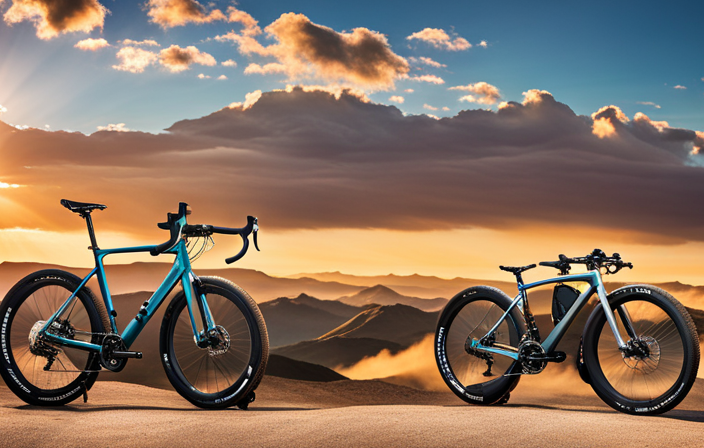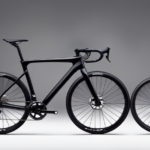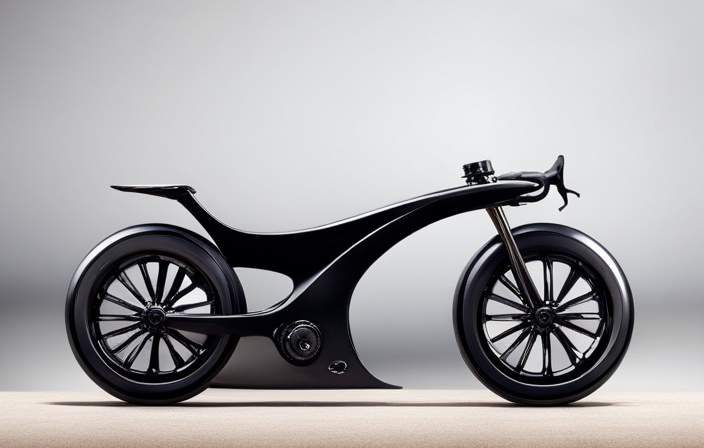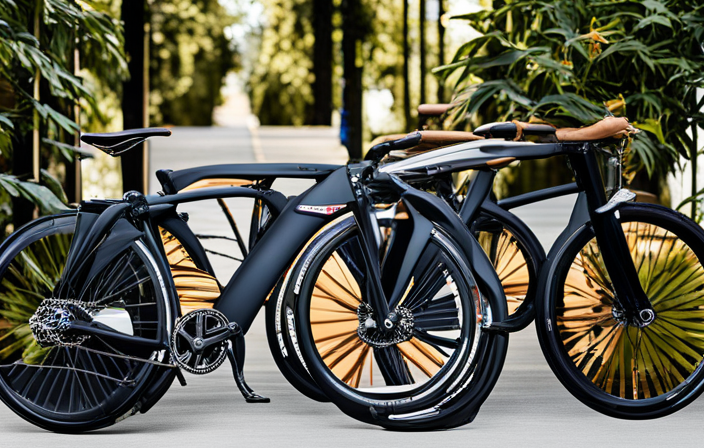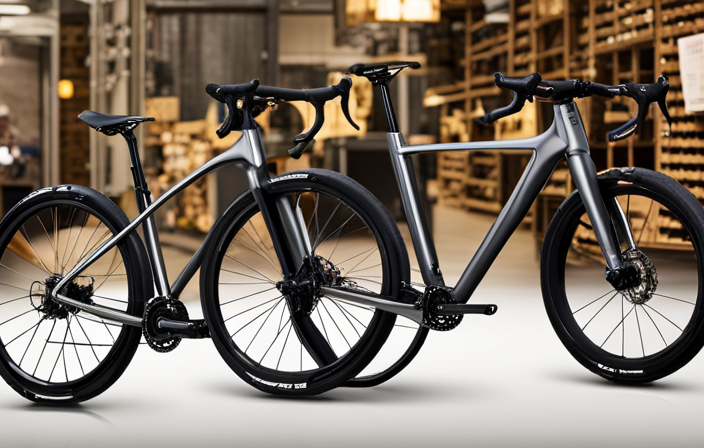What type of stem is optimal for your gravel bike?
Well, get ready to discover the key factors to consider when choosing the perfect stem.
In this article, I will guide you through the importance of the stem in gravel biking and provide detailed insights on how to select the right length, angle, material, and handlebar compatibility.
We’ll also discuss test riding options and consulting with professionals for expert advice.
So let’s dive into this suspenseful journey of finding the ideal stem for your gravel bike!
Key Takeaways
- Stem selection is important for gravel biking as it affects rider’s position, comfort, riding technique, and performance.
- Factors to consider in stem selection include reach, stack height, angle, material, weight, handlebar compatibility, fork steerer tube diameter, and consulting with professionals.
- Stem and handlebar compatibility is crucial, with longer stems suitable for aggressive riding positions and shorter stems for relaxed and upright positions.
- Fine-tuning riding position through adjustable features can alleviate discomfort, enhance efficiency and performance, and cater to aesthetic preferences.
Understanding the Importance of the Stem in Gravel Biking
The stem is an essential component for a gravel bike, as it affects the rider’s position and comfort. When it comes to riding technique and performance benefits, choosing the right stem can make a significant difference.
The stem connects the handlebars to the fork steerer tube, determining how far forward or upward the handlebars are positioned. This directly impacts your riding position and overall comfort on the bike.
A shorter stem, typically around 70-90mm in length, offers quicker handling and more responsive steering. It brings you closer to the front wheel, making it easier to navigate tight corners and technical sections. On the other hand, a longer stem of around 100-120mm provides stability at higher speeds and better weight distribution for climbing steep inclines.
Consider your riding style and goals when selecting a stem. If you prioritize speed and aggressive off-road riding, a shorter stem may be more suitable. However, if endurance rides or long-distance touring are your focus, a longer stem might provide greater comfort over extended periods.
When considering your stem options, also take into account factors such as reach (horizontal distance from saddle to handlebars), stack height (vertical distance from bottom bracket to top of head tube), rise angle (tilting angle of the handlebars), and material construction.
In conclusion, choosing the right stem for your gravel bike can significantly enhance your riding experience by optimizing your position on the bike.
Consider Your Riding Style and Goals
When choosing a stem for your gravel bike, it’s important to consider your riding style and what you hope to achieve. Conducting a thorough analysis of your riding style will help determine the type of stem that best suits your needs.
Are you an aggressive rider who enjoys pushing the limits on challenging terrain? Or do you prefer a more relaxed and comfortable ride, taking in the scenery at a leisurely pace? Understanding your riding style will guide you towards the right stem that can enhance your performance and overall experience.
Goal setting is also crucial when selecting a stem for your gravel bike. What are you hoping to accomplish with your rides? Are you aiming to improve speed and efficiency, or are you focused on endurance and long-distance comfort? Your goals will influence the type of stem you choose, as different stems offer varying degrees of stiffness, adjustability, and aerodynamics.
By considering both your riding style and goals, you can narrow down the options for stems that would be most suitable for your gravel bike. Determining the length and angle that fits your body geometry is the next step in finding the perfect stem to optimize comfort and handling on any terrain.
Determine the Length and Angle that Fits Your Body Geometry
To optimize comfort and handling on any terrain, it’s important to determine the length and angle that best fits your body geometry when selecting a stem for your gravel bike. Proper body positioning is crucial for rider comfort, especially during long rides or rough terrains. Here are four key factors to consider when determining the length and angle of your stem:
-
Reach: The length of the stem affects how far you have to reach to grab the handlebars. A shorter stem provides a more upright position, ideal for riders seeking a relaxed and comfortable riding experience.
-
Stack Height: The stack height determines the vertical distance between the handlebars and the bottom bracket. A higher stack height allows for a more upright riding position, reducing strain on your back and neck.
-
Angle: The angle of the stem refers to its rise or drop in relation to the fork steerer tube. An adjustable angle stem can help fine-tune your riding position based on personal preference.
-
Trail: The trail is influenced by both the head tube angle and fork rake, affecting how stable your bike feels at different speeds.
By carefully considering these factors, you can find a stem length and angle that optimizes both rider comfort and handling performance on your gravel bike.
Now let’s assess the material and weight of the stem in order to further enhance your riding experience.
Assess the Material and Weight of the Stem
Assessing the material and weight of your stem can greatly enhance your riding experience.
When it comes to material options, there are a few choices to consider. Aluminum stems are popular due to their lightweight nature and affordability. They provide good durability and stiffness, making them suitable for most gravel riding situations.
Carbon fiber stems, on the other hand, offer even lighter weight and better vibration damping properties. However, they tend to be more expensive than aluminum stems.
Titanium is another option that provides a balance between weight savings and strength but comes with a higher price tag.
Weight considerations are also important when choosing a stem for your gravel bike. A lighter stem can improve the overall handling and responsiveness of your bike, especially when maneuvering through technical sections or climbing steep hills. However, it’s crucial to find the right balance between weight savings and durability.
When considering handlebar compatibility in the subsequent section, you need to ensure that both the stem and handlebar have matching clamp diameters to ensure a secure fit without compromising safety or performance.
Consider the Handlebar Compatibility
Make sure the handlebar you choose is compatible with your stem to ensure a secure fit and optimal performance. When considering the handlebar compatibility, there are two key factors to take into account: handlebar height and handlebar width.
Handlebar Height:
The height of your handlebar plays a crucial role in determining your riding comfort and efficiency. It is essential to select a stem that allows you to achieve the desired handlebar height. Some stems come with adjustable angles, enabling you to fine-tune the height according to your preferences. Additionally, consider the type of riding you will be doing; for more aggressive off-road riding, a lower handlebar position may be desired for better control.
Handlebar Width:
The width of your handlebars affects your stability and handling on different terrains. A wider bar provides more leverage, making it easier to navigate technical sections or maneuver through tight spaces. However, it’s important not to go too wide as it can lead to discomfort or limited clearance between trees on narrow trails.
Taking these factors into consideration will help you select a stem that complements the handlebars you desire. Now, let’s move on to discussing how to take into account the fork steerer tube diameter when choosing a stem for your gravel bike.
Take into Account the Fork Steerer Tube Diameter
Consider the diameter of your fork steerer tube when choosing a compatible stem for optimal performance and secure fit on your gravel bike. Fork steerer tube compatibility is crucial in ensuring that the stem is properly attached to the bike’s fork and provides stability during rides.
The fork steerer tube, located at the top of the front fork, comes in various diameters, so it is important to measure this accurately before selecting a stem.
When it comes to stem length options, they can vary depending on personal preference and riding style. Longer stems provide a more stretched out and aggressive riding position, which may be suitable for riders who prioritize speed and aerodynamics. On the other hand, shorter stems offer a more relaxed and upright position, enhancing comfort during long rides or off-road excursions.
To transition into evaluating the clamp diameter for the handlebars, it is essential to ensure that your chosen stem has an appropriate clamp size that matches your handlebar’s diameter. This ensures a secure connection between the two components and prevents any slippage or instability while riding.
Now let’s move on to assessing the clamp diameter for the handlebars to complete our selection process for an ideal gravel bike stem.
Evaluate the Clamp Diameter for the Handlebars
When choosing a stem for your gravel bike, it’s important to evaluate the clamp diameter for the handlebars to ensure a secure fit and prevent any slippage while riding. The handlebar clamp size refers to the diameter of the stem where it attaches to the handlebars. This measurement is crucial because if the clamp diameter is too large or too small for your handlebars, it can lead to instability and compromise your control over the bike.
To help you find the right stem for your gravel bike, here’s a table detailing common handlebar clamp sizes:
| Handlebar Clamp Size (mm) | Compatibility |
|---|---|
| 25.4 | Older road bikes and some mountain bikes |
| 31.8 | Most modern road and mountain bikes |
| 35 | High-performance mountain bikes |
Once you’ve identified the appropriate handlebar clamp size, you’ll also want to consider stem length adjustment. This feature allows you to fine-tune your riding position by adjusting how far forward or back your handlebars are from the steerer tube.
Look for adjustable features that allow you to fine-tune your position for optimal comfort and performance on your gravel bike without compromising stability or control in any way.
Look for Adjustable Features for Fine-tuning Your Position
When evaluating the clamp diameter for the handlebars on a gravel bike, it is crucial to ensure a proper fit that promotes comfort and control. However, even after finding the right clamp diameter, there may still be some fine-tuning required to achieve an optimal riding position. This is where adjustable features come into play.
Adjustable features allow you to make small tweaks and refinements to your bike fit, providing maximum comfort adjustment. These features can include an adjustable stem length or angle, allowing you to customize your riding position based on your preferences and body geometry. By making these adjustments, you can alleviate any discomfort or strain that may arise from an improper bike fit.
Fine-tuning your position not only enhances comfort but also improves efficiency and performance while riding. It enables you to find the sweet spot where power transfer is maximized, ensuring that every pedal stroke counts.
Now that we have discussed how to evaluate the clamp diameter and adjust your riding position for optimal bike fit and comfort adjustment, let’s consider the aesthetic and design preferences when choosing a stem for your gravel bike.
Consider the Aesthetic and Design Preferences
To find a stem that matches your personal style and preferences, take into account the aesthetic and design elements that appeal to you. When it comes to gravel biking, not only is functionality important, but so is the overall look of your bike. The stem is a prominent component that can greatly influence the visual appeal of your gravel bike.
When considering aesthetic preferences, think about the shape and color of the stem. Some riders prefer a sleek and minimalist design with clean lines, while others may opt for a more bold and eye-catching appearance. Additionally, consider whether you want a stem with graphics or branding that aligns with your personal style.
Design preferences encompass various factors such as length, rise, and material. A longer stem can provide stability for off-road riding, while a shorter one offers quicker handling on technical terrain. The rise refers to the angle at which the handlebars are positioned relative to the steerer tube. Materials like aluminum or carbon fiber offer different levels of weight savings and stiffness.
Consider these aspects when selecting a stem that suits your desired aesthetic and design preferences. By finding one that matches your style while also meeting practical needs for gravel biking, you will have an enjoyable riding experience.
As you explore options for stems based on aesthetic and design preferences, it’s essential to read reviews and seek recommendations from other gravel bikers who have already tested different products out in real-world conditions. This will provide valuable insights into how well certain stems perform in terms of durability, comfort, and overall performance on rough terrains.
Read Reviews and Seek Recommendations from Other Gravel Bikers
It’s important to gather feedback and recommendations from fellow gravel bikers when considering different stem options. Seeking recommendations and reading reviews can provide valuable insights into the performance, durability, and overall satisfaction of a particular stem.
There are numerous online forums, social media groups, and cycling communities where you can connect with experienced gravel riders who are willing to share their thoughts on various stems.
When seeking recommendations, it’s crucial to consider the specific needs and preferences of your riding style. Some riders may prioritize stiffness for optimal power transfer, while others may prefer a more compliant and comfortable ride. Reading reviews can help you gauge how well a stem performs in these areas based on real-world experiences.
A good approach is to look for consensus among multiple sources. If several reputable reviewers or fellow gravel bikers consistently praise a particular stem for its reliability, responsiveness, and overall quality, it’s likely worth considering.
Transitioning into the next section about taking your budget into consideration: While gathering recommendations is essential in choosing the right stem for your gravel bike, it’s also crucial to take your budget into consideration without compromising quality or performance.
Take Your Budget into Consideration
Considering your budget is important when choosing a stem for your gravel biking setup, as you want to ensure quality and performance without overspending. A stem is a crucial component that connects the handlebars to the fork steerer tube, providing stability and control while riding off-road. When selecting a stem, it is essential to take into account your riding style compatibility, as different stems offer varying degrees of responsiveness and handling characteristics.
Durability and longevity are also key factors to consider. Gravel riding can be demanding on equipment, with rough terrain and vibrations putting components through their paces. Investing in a well-built stem made from high-quality materials will ensure it can withstand the rigors of gravel biking for years to come.
To help you make an informed decision within your budget, here’s a helpful table comparing different stems:
| Stem Model | Price Range | Material | Weight (grams) |
|---|---|---|---|
| Stem A | $50-$100 | Aluminum | 120 |
| Stem B | $100-$150 | Carbon Fiber | 90 |
| Stem C | $150-$200 | Titanium | 110 |
By considering these options based on price range, material, and weight, you can find a stem that meets both your budgetary constraints and performance needs. With this knowledge in hand, you’ll be ready to test ride different stems if possible and evaluate how they enhance your gravel biking experience.
[Transition sentence into next section about test ride different stems if possible.]Test Ride Different Stems if Possible
If you have the opportunity, try out various stems to see how they improve your riding experience. Test ride experience is crucial when it comes to finding the right fit for your gravel bike. Stems play a significant role in determining your bike’s handling and comfort, so it’s essential to choose one that suits your preferences and riding style.
During a test ride, pay attention to how different stems affect your bike’s responsiveness and stability. A shorter stem can make the steering feel quicker and more nimble, while a longer stem may provide better stability at higher speeds. Additionally, consider the rise and length of the stem, as these factors can influence your riding position and overall comfort.
To get the most accurate sense of how a particular stem feels, try testing it on various terrains. Ride over rough gravel roads, climb steep hills, and navigate tight corners to gauge its performance in different scenarios. This will give you a comprehensive understanding of how each stem enhances or detracts from your riding experience.
Once you’ve gathered feedback from test rides, consult with a professional bike fitter for expert advice on choosing the best stem for your gravel bike setup. They can analyze your body position on the bike and recommend adjustments or alternative options based on their expertise.
Consult with a Professional Bike Fitter for Expert Advice
Consulting with a professional bike fitter is essential for receiving expert advice on selecting the most suitable stem for your gravel bike setup. A bike fit is crucial to ensure that your body is properly aligned and comfortable while riding. A professional bike fitter will take into account your body measurements, flexibility, riding style, and goals to recommend the right stem length and angle.
When it comes to choosing a stem for your gravel bike, there are various factors to consider. The length of the stem affects the reach and handling of the bike, while the angle determines the height of your handlebars. A professional bike fitter will analyze these factors based on their experience and knowledge, providing personalized recommendations tailored to your specific needs.
By consulting with a professional, you can avoid potential issues such as discomfort or even injury caused by an ill-fitting stem. Their expertise will help you optimize your riding position and maximize efficiency on different terrains. They can also provide valuable insights on other components that may need adjustment or replacement to further enhance your overall biking experience.
Understanding the warranty and customer support options available for stems is important when making a decision about which one to purchase. This information ensures that you have access to assistance in case of any issues or questions that may arise during installation or use of the stem.
Understand the Warranty and Customer Support Options
To understand the warranty and customer support options, make sure you research the available assistance for any potential issues or questions that may arise during installation or use of your stem. It is crucial to be aware of the warranty coverage provided by the manufacturer, as this will determine what repairs or replacements are eligible in case of defects or damage. Additionally, understanding the customer service options available can greatly impact your overall experience with the product.
When considering warranty coverage for your gravel bike stem, keep these factors in mind:
- Duration: How long does the warranty last? Is it limited to a specific period of time?
- Coverage: What types of issues are covered under the warranty? Are there any exclusions?
- Claim Process: How easy is it to file a claim? Are there specific steps or documentation required?
In terms of customer service options, consider:
- Availability: Is customer support accessible via phone, email, or chat?
- Response Time: How quickly can you expect a response from their customer service team?
- Expertise: Does the company have knowledgeable staff who can assist you with technical questions?
By thoroughly researching and understanding these aspects, you can ensure that you have adequate support should any problems arise with your gravel bike stem. This knowledge will help you finalize your decision based on factors that matter most to you when selecting a stem for your gravel bike.
Finalize Your Decision Based on the Factors That Matter Most to You
Now that I have a clear understanding of the warranty and customer support options for gravel bikes, it’s time to finalize my decision based on the factors that matter most to me.
As an avid cyclist, I place great importance on riding techniques and the components of a gravel bike.
When it comes to riding techniques, I prefer a bike that offers stability and control on various terrains. This means considering factors such as frame geometry, tire clearance, and suspension options. A gravel bike with a longer wheelbase and relaxed head tube angle can provide better stability when tackling rough or loose surfaces. Additionally, having ample tire clearance allows for the use of wider tires which offer increased traction and comfort.
In terms of components, durability and reliability are key considerations. Opting for high-quality drivetrain components ensures smooth gear shifting even in challenging conditions. Hydraulic disc brakes provide powerful stopping power regardless of weather conditions or terrain types. Furthermore, choosing a lightweight but robust frame material like carbon fiber or aluminum can enhance overall performance without compromising strength.
By focusing on these aspects – riding techniques and gravel bike components – I can confidently make my final decision knowing that I have thoroughly considered all the necessary factors for an optimal riding experience.
Frequently Asked Questions
What are the different types of stems available for gravel bikes?
When it comes to gravel bike stem lengths, there are a variety of options available. The length of the stem affects the bike’s handling and comfort, so it is important to choose one that suits your riding style.
Additionally, the best materials for gravel biking stems are lightweight yet durable, such as aluminum or carbon fiber. These materials provide strength while keeping weight to a minimum, allowing for better performance on rough terrain.
How can I determine the correct stem length and angle for my body geometry?
Determining the correct stem length and angle for your body geometry is crucial for optimal comfort and performance on a gravel bike.
Body geometry plays a vital role in finding the right fit, as it affects your posture and reach while riding.
To determine the ideal stem length, consider factors such as arm length, shoulder width, and flexibility.
Additionally, assessing your riding style and preferences can further guide you in selecting the appropriate stem angle to ensure a comfortable and efficient riding position.
Are there any specific handlebar compatibility requirements that I should consider?
When considering handlebar compatibility for a gravel bike, it’s crucial to pay attention to two key factors: handlebar clamp sizes and compatibility with integrated accessories.
Handlebar clamp sizes refer to the diameter of the handlebars, which must match the stem’s clamp diameter for a secure fit.
Additionally, you should consider if your chosen handlebar is compatible with any integrated accessories you may want to add, such as lights or computer mounts.
Ensuring these factors align will guarantee a smooth and functional setup for your gravel bike.
What are the benefits of adjustable features in a stem?
The benefits of adjustable stems are numerous. They allow for a personalized fit, ensuring optimal comfort on the bike. By adjusting the angle and length of the stem, riders can achieve their desired riding position, reducing strain on the back, neck, and shoulders.
Adjusting the stem also allows for fine-tuning handling characteristics, improving control and responsiveness. To adjust a stem for optimal comfort, simply loosen the bolts, make adjustments as needed, and then tighten the bolts to secure in place.
How do I choose a stem based on aesthetic and design preferences?
When it comes to choosing a stem based on aesthetic and design preferences, it’s important to consider both the materials used and their impact on bike handling.
The choice of stem materials, such as aluminum, carbon fiber, or titanium, can affect the weight and stiffness of your bike.
Additionally, the design of the stem can have an impact on how your bike handles.
So, take your time to research different options and find a stem that not only looks great but also enhances your riding experience.
Conclusion
In conclusion, selecting the right stem for your gravel bike is a crucial decision that should not be taken lightly. It is like choosing the perfect foundation for a building – it provides stability, comfort, and control.
By considering factors such as riding style, body geometry, material, handlebar compatibility, and expert advice from a professional bike fitter, you can ensure that you find the ideal stem for your needs.
Remember to test ride different options and take advantage of warranty and customer support options to make an informed decision.
Happy riding!
